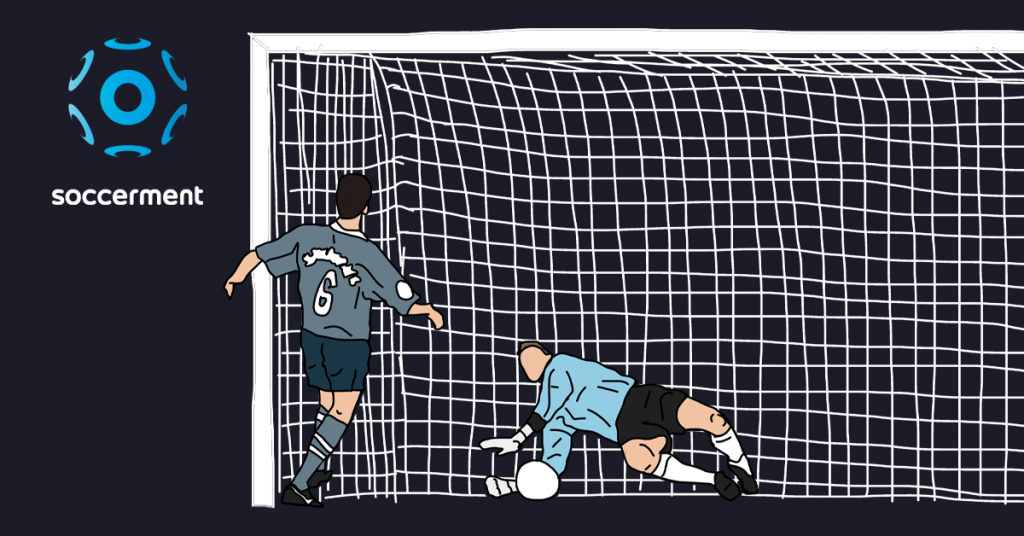In a tournament like the European Championship, the difference between victory and defeat is often determined by penalties. Since 1976, more than one-fourth of the knock-out matches have indeed been decided by penalty shoot-outs (27.7%). Skilled finishers who are able to handle high pressure can clearly become a decisive factor in such a competition. Obviously, the same could be said for goalkeepers, but this report will focus on the shooters and try to answer a few questions: Where do left-footed players shoot the most? Where should right-footed players direct their attempts? Who are the top penalty takers at UEFA EURO 2020? Finally, is it sensible to try a ‘Panenka‘?
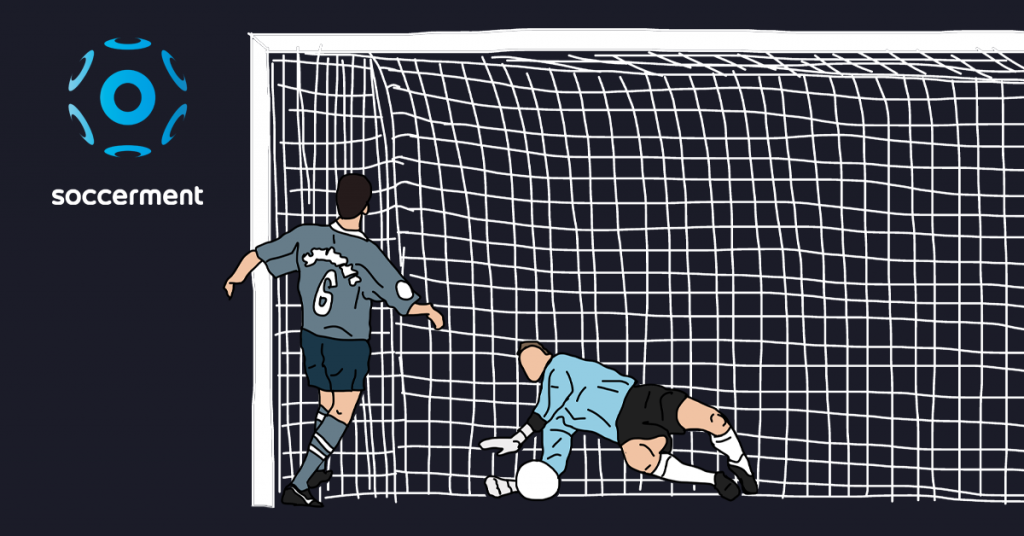
Penalty shoot-outs at the European Championship
Penalties were first introduced in 1891, but the first major international tournament to be decided by a penalty shoot-out was the 1976 European Championship, with the final between Czechoslovakia and West Germany. Have you ever heard of Antonín Panenka?
Since 1976, in the European Championship, 18 knock-out matches out of 65 have been decided by penalty shoot-outs, i.e. more than one-fourth of total knock-out matches (27.7%). If these numbers were to be repeated, four matches of EURO 2020 will end with emotion-charged penalty shoot-outs.
On average, slightly more than three penalties are scored out of four attempts, with a conversion of between 75% and 80% depending on the competition.
Expected Goal models normally attribute to penalties a value of 0.76. We note that in the top seven European leagues, in the past four seasons, the average conversion rate has been slightly higher (78%), but lower than the one reported in the European Championship’s penalty shoot-outs: before EURO 2020, in 18 penalty shoot-out sequences at a European Championship, a grand total of 195 penalties were taken, of which 155 goals were scored (conversion rate of 79.5%).
There have been numerous studies trying to evaluate what is the best shooting technique, whether right-footed players shoot better than left-footed players or how much is the influence of the psychological factors when it comes to taking penalties. What does data tell us?
The art of penalty-taking
Dissecting 11,635 penalties
Our total database consists of 11,635 penalties, of which 9,035 scored, for a conversion rate of around 78%.
However, this report focuses on the 2,133 penalties taken from those players representing the teams at Euro 2020 and that have taken at least one penalty in one of Europe’s top seven leagues. We consider all the penalties taken in both club and national competitions, including shoot-outs and the database was last updated just before the last league matchday of the 2020/21 season (EURO 2020 is therefore excluded from the sums).
The total list consists of 248 players, 190 of these are right-footed while 58 are left-footed. Although some players are completely ambidextrous, they have usually been consistent with their dominant foot with regards to penalties: Ivan Perisic takes free-kicks with both feet, but shoots penalties with his left foot; Ousmane Dembelé seems to be unsure himself about being right or left-footed (video here), but at least we know that he took his last three penalties with his right foot.
Dividing the goal into nine areas
Football rules state that a goal should be made by two posts which are 2.44 meters high (8ft) divided by 7.32 meters (24ft). The posts should be white and of the same volume as the crossbar, in any case not exceeding 12 cm in width.
In order to better understand shot directions and the related conversion rates, we grouped all the shots into one of nine areas depending on the height and the lateral direction of the shot: high-left, mid-left, low-centre, etc. So, if a shooter takes a penalty which ends out on the right between the post and the touchline (on the keeper’s left), the shot will be counted as a low-right. The grouping regards the attempts and not the end results, so if a penalty shot goes off target but was intended to be directed to low-right, we classified it there. In the example below, both shots are classified as “low-right”.
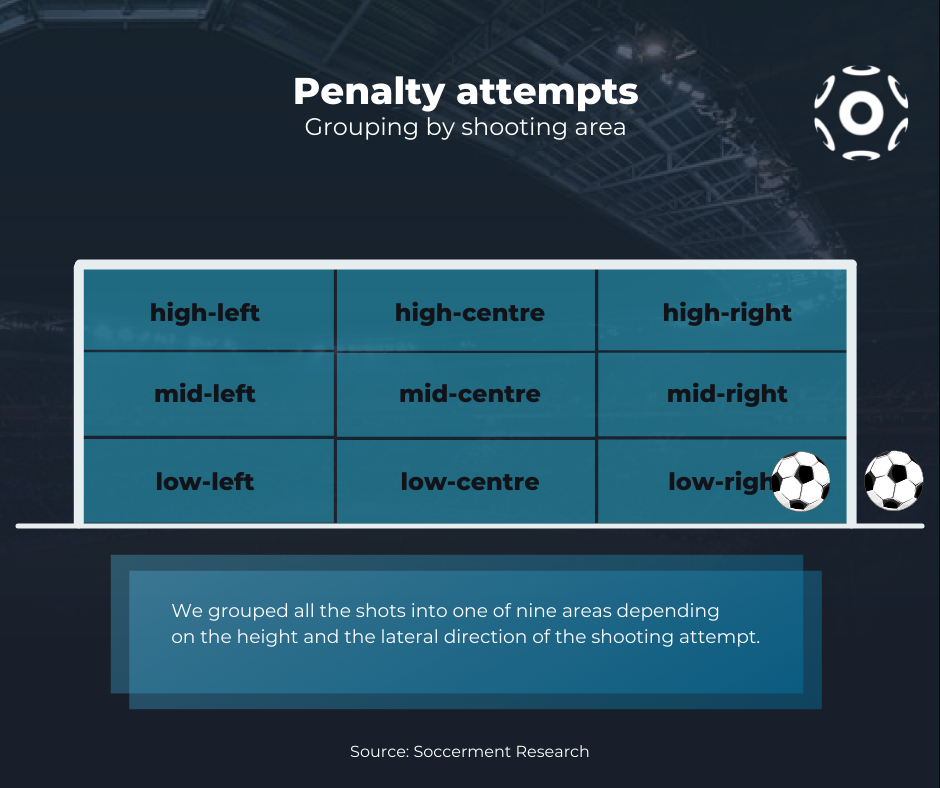
Penalty evaluation
Out of the 2,133 penalties which we have taken into consideration, 1710 resulted in a goal, translating into conversion rate of 80.2%.
Right foot vs. Left foot
The 2,133 penalties have been taken by 248 shooters, 190 are right-footed (76.6%), while 58 are left-footed (23.4%). A total of 1,653 penalties have been taken with the right foot against the 480 taken with the left.
Right-footed shooters have scored 1,322/1,653 penalties (80% conversion rate), while left-footed shooters have scored 388/480 penalties (80.8% conversion rate).
Direction of the shots
More can be said with regards to the direction of the shots. On average, right-footed shooters tend to shoot more towards their left while left-footed players tend to shoot more towards their right.
What is apparent is that most players tend to go for a low-driven shot (as shown in the image), 67.4% of penalties are directed towards the bottom-third of the goal, 21.5% of shots were directed towards the middle-third and only 11.1% of the penalties were directed towards the upper-third.
As shown in the figure below, right-footed players normally shoot towards the “opposite post” and their top target is represented by the low-left corner.
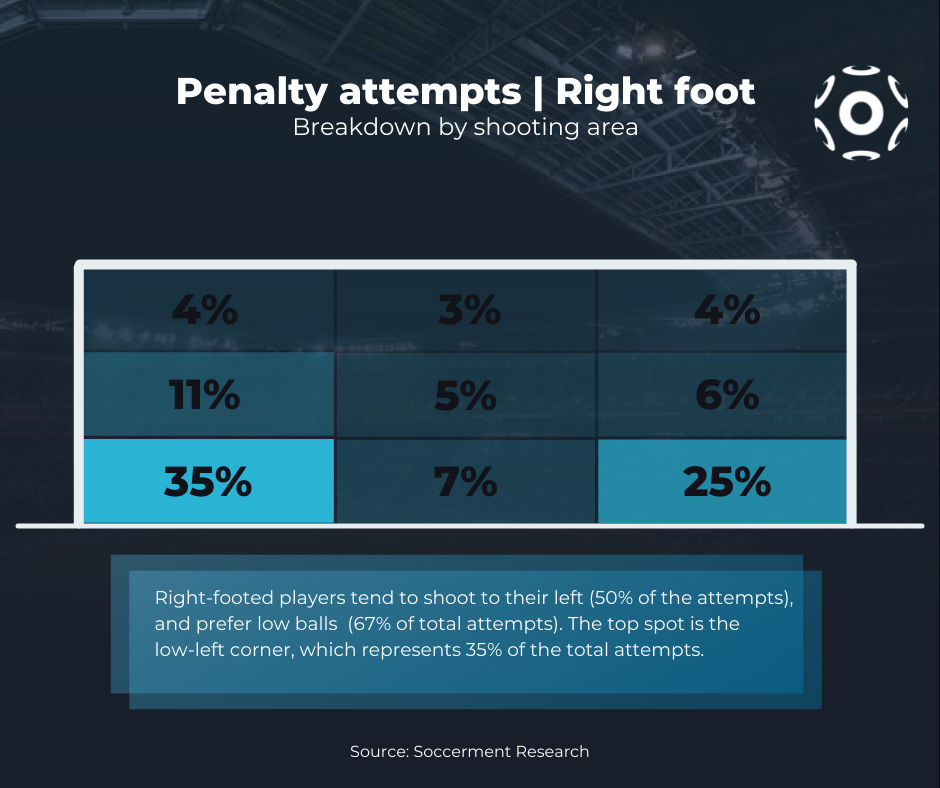
Similarly, left-footed players shoot mostly to their right and their top target is the bottom-right corner, where they direct almost one-third of their penalty shots.
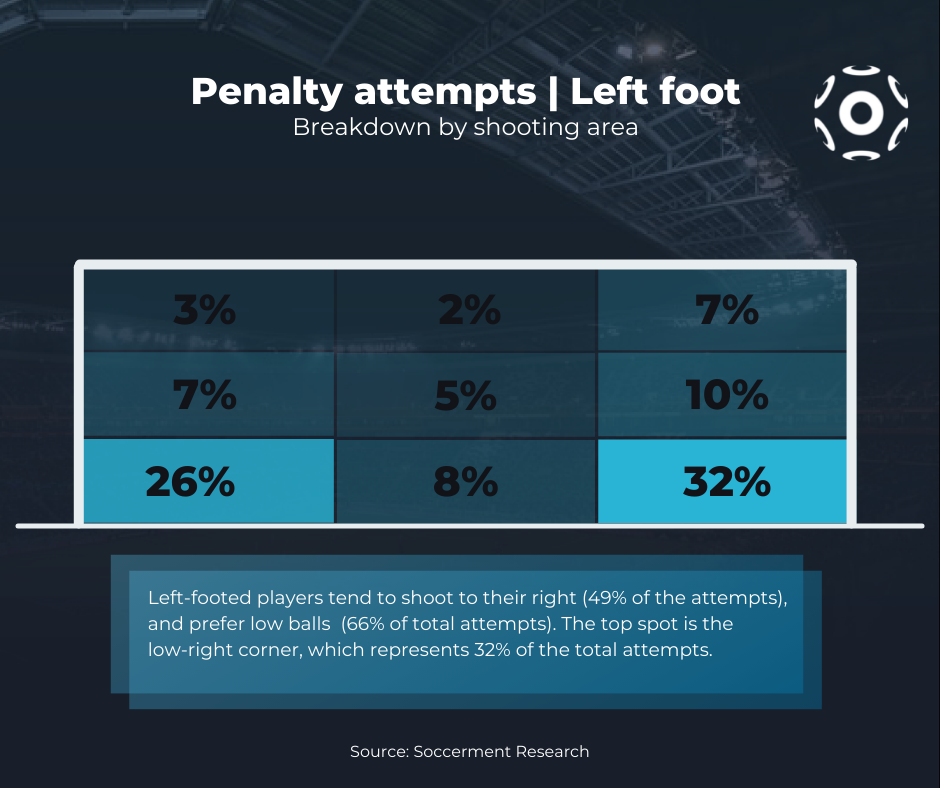
Panenkas generally work, until they do not…
When crunching the numbers for this report, we found ourselves in front of a very counterintuitive result, which we actually had to check a few times before submitting the report.
It regards the different conversion rates of the penalty attempts in the nine areas of the goal, as highlighted above.
Well, it turns out that the highest conversion rate, for both right-footed and left-footed players, is achieved in the area where you are taught NOT to shoot at the football academy: central and in the middle-third, basically among the arms of a goalie, if she/he stood still.
Does that mean that goalkeepers tend to choose one side and start moving there, before the penalty is actually kicked? Probably. Consequently, does that mean that shooting in the middle, for example through a ‘Panenka‘, is the most rational thing to do for a penalty taker? Probably.
Unfortunately, our dataset doesn’t currently comprise the goalkeepers’ movements on the penalty kick and so it not possible to infere that conclusion. Surely, this is food for thought and we’ll investigate it further.
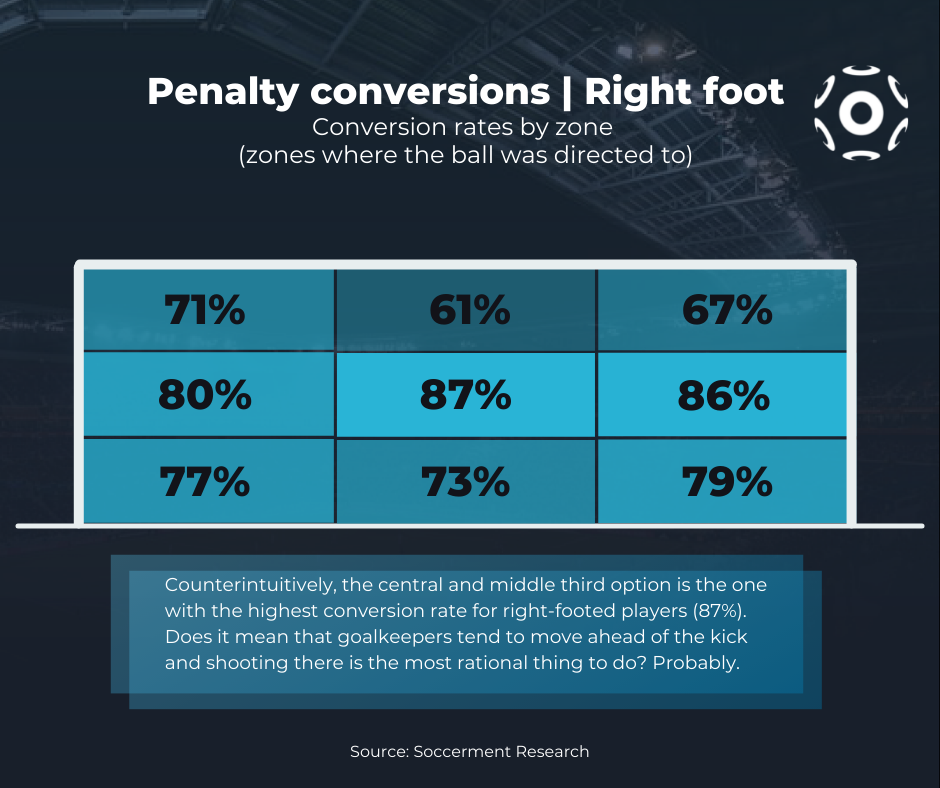
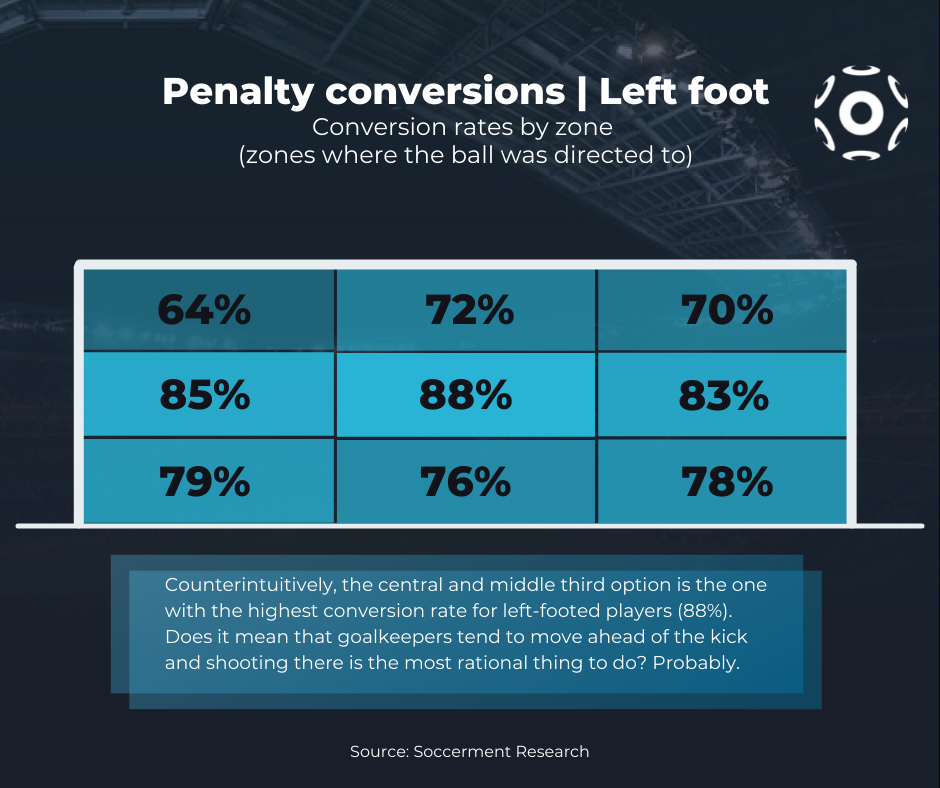
Three important considerations need to be made here though:
- As we showed in the charts related to the penalty attempts, only a few penalty shots are directed to the centre of the goal (around 5% of total). This clearly limits the statistical relevance of the observation;
- Goalkeepers might generally move ahead of the penalty kick towards one or the other side, but they rationally do so because most of the shots, as seen, are directed there. If players were to start shooting mostly towards the centre of the goal, keepers would likely adjust their behaviour.
- Panenka penalties might look like the most rational solution, according to our dataset. However, they remain extremely risky, as a lot of technical skills are involved, for instance the ability to deceive the goalie with an unnatural movement, plus the ability to chip the ball, touching it in the perfect spot. The combination of these factors doesn’t always go according to plans, as it happened twice last season in the Premier League: Fulham’s Ademola Lookman and City’s Sergio Agüero might still have bad dreams about those missed Panenkas.
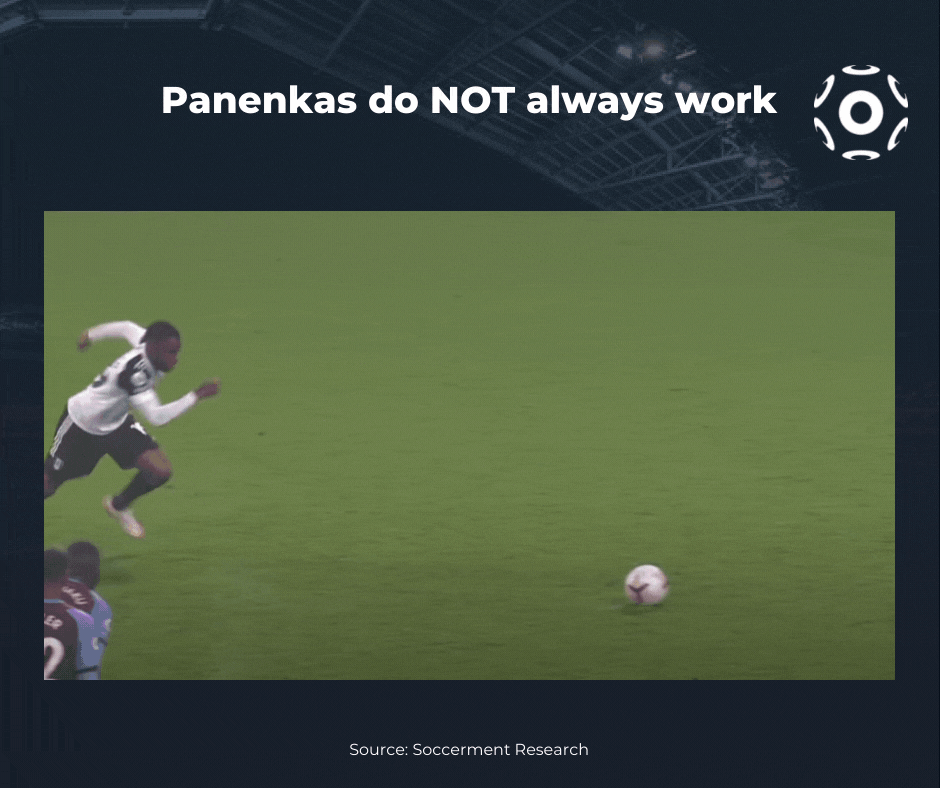
Evaluating the best penalty takers
Out of all players participating at EURO 2020, Cristiano Ronaldo is by a far margin the player who has taken the most penalties for club and country (166) and also the player who has scored the most (140).
While being able to shoot and score with consistency is important, the most important factor when evaluating the skill of a penalty shooter is his conversion rate. Obviously, working with bigger numbers makes the estimate more accurate (scoring 3 penalties out of 3 can easily happen also by chance, scoring 30 out of 30 by chance is almost impossible), so we decided to set a threshold and analyse only the players with at least 10 penalties.
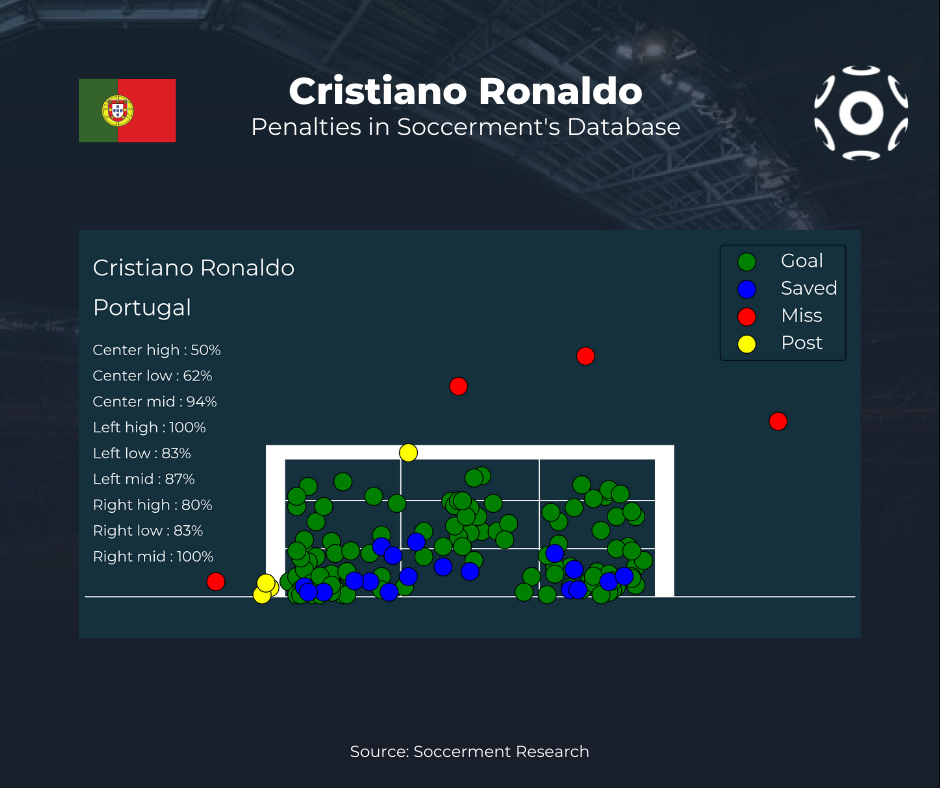
So, out of the players who have taken at least 10 penalties, who has the best conversion rate?
The best player in this regard is known for his ability to take penalties, but funnily enough, he isn’t the designated shooter for his country, who are we talking about? Bruno Fernandes. The Portuguese has scored 45 penalties out of 47 taken, leaving him with a remarkable conversion rate of 95.7%.
To complete the podium we have Andriy Yarmolenko who has scored 15 penalties out of 16 taken (93.8% conversion rate) and Sérgio Oliveira who has scored 14 of his 15 penalties (93.3% conversion rate). Here is the top 10 of the players participating in the knock-out phase (so, no Lewandowski here), sorted by their conversion rates (caveat: at least 10 penalties taken):
- B. Fernandes (POR): 45/47 penalties scored (95.8% conversion rate);
- A. Yarmolenko (UKR): 15/16 penalties scored (93.8% conversion rate);
- S. Oliveira (POR): 14/15 penalties scored (93.3% conversion rate);
- Y. Carrasco (BEL): 10/11 penalties scored (90.9% conversion rate);
- A. Kramaric (CRO): 29/32 penalties scored (90.6% conversion rate);
- K. Dolberg (DEN): 9/10 penalties scored (90% conversion rate);
- K. Benzema (FRA): 16/18 penalties scored (88.9% conversion rate);
- I. Gündogan (GER): 15/17 penalties scored (88.2% conversion rate);
- H. Kane (ENG): 44/50 penalties scored (88% conversion rate);
- E. Hazard (BEL): 47/54 penalties scored (87% conversion rate).
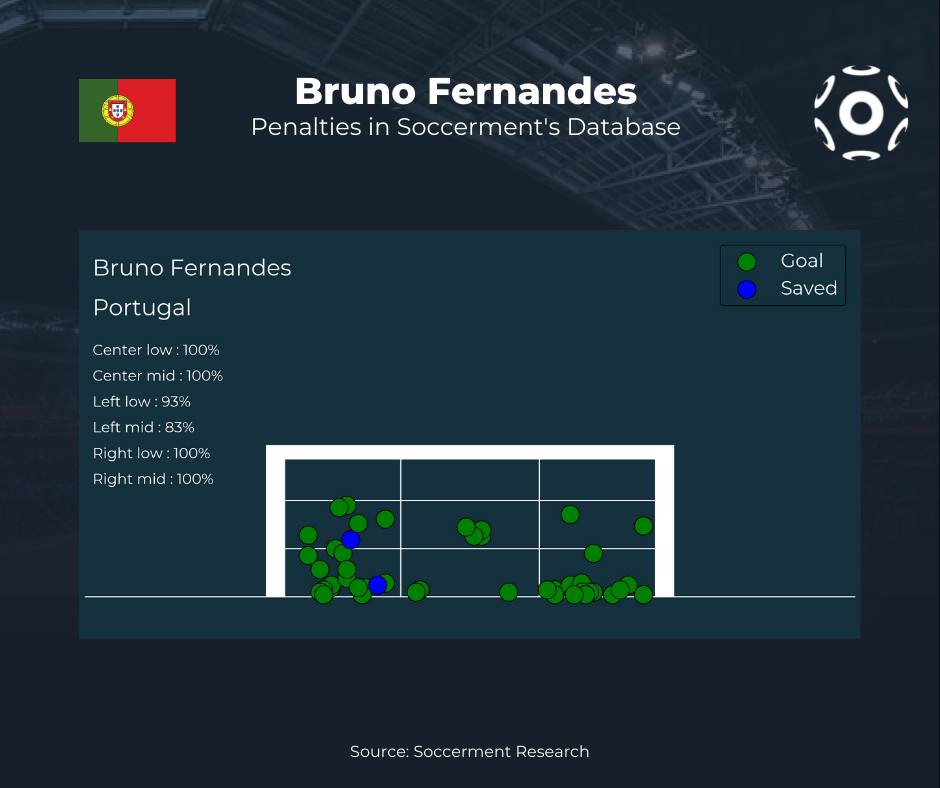
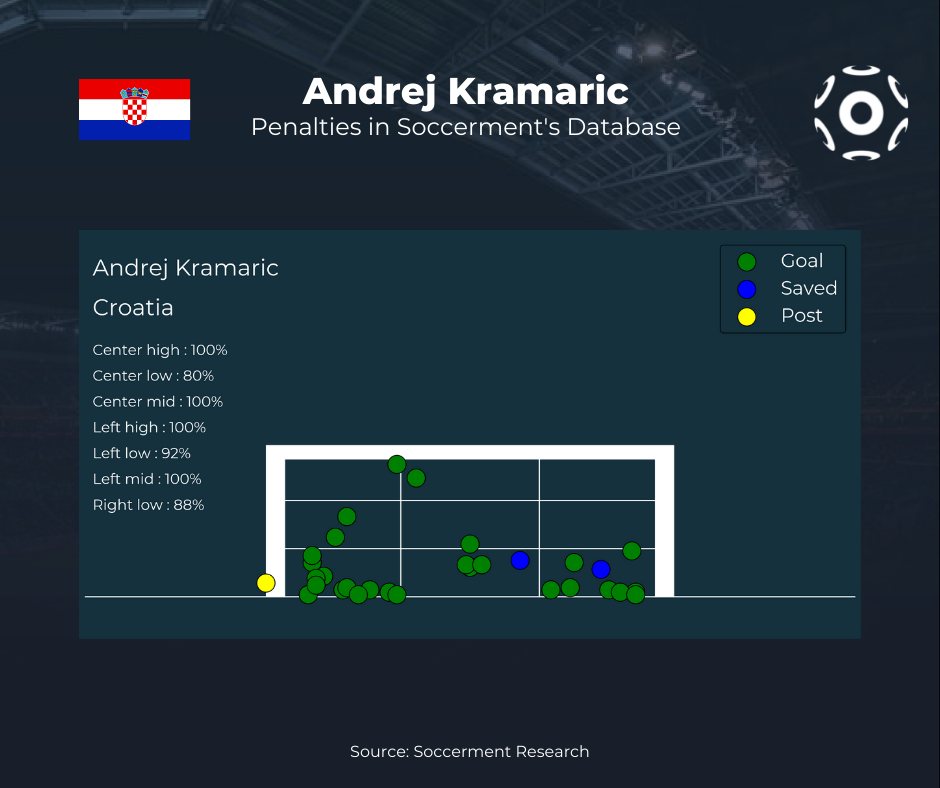
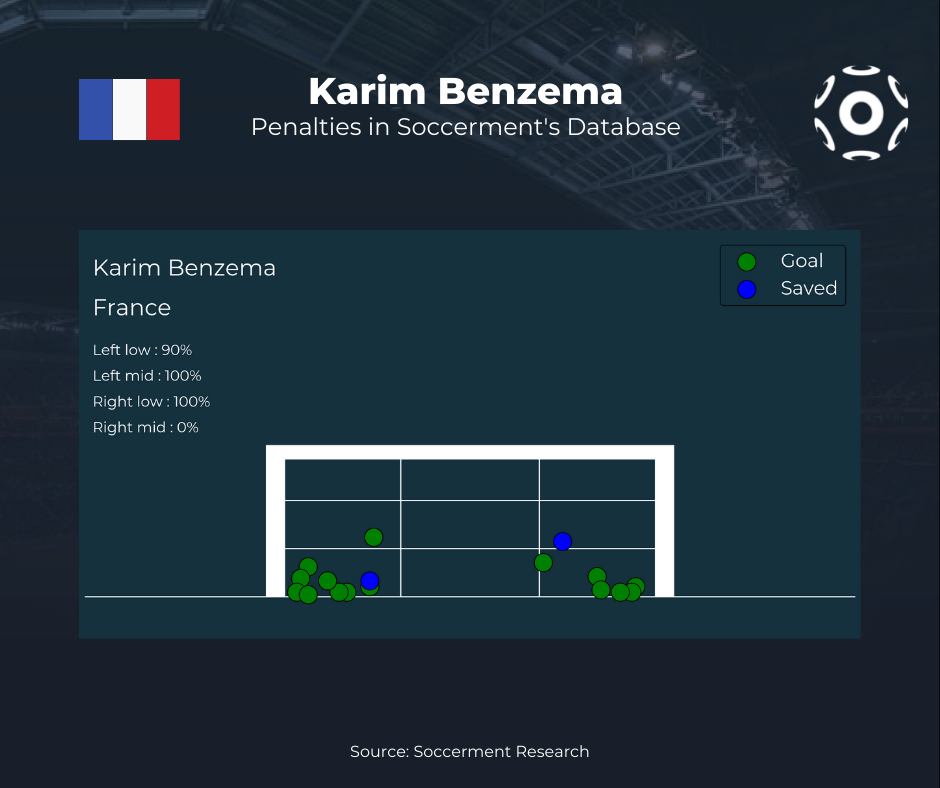
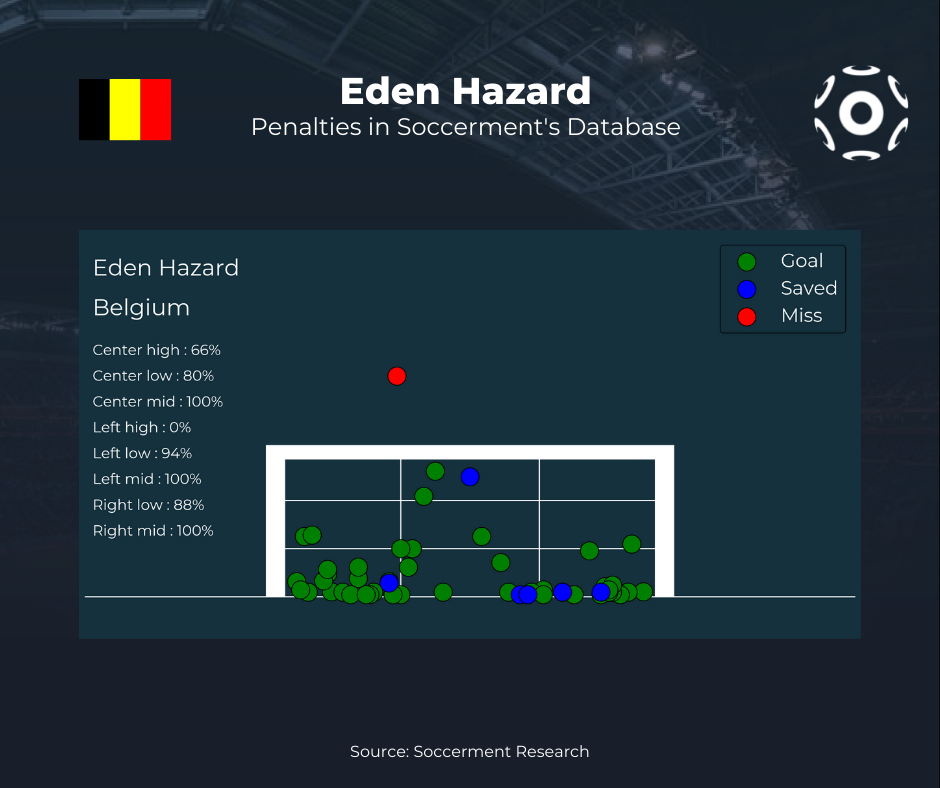
The “worst 10” contains some interesting names and features a group of players from the Netherlands (per example, Memphis Depay who is the designed shooter has a conversion rate of 74.1%), so Frank de Boer might take this into consideration if they ended up in a penalty shootout. On the contrary, the Netherlands have two excellent shooters sitting on the bench: Steven Berghuis converts at a rate of 86.2%, while Teun Koopmeiners converts at a rate of 82.4%; they could definitely be useful in case of a penalty shoot-out.
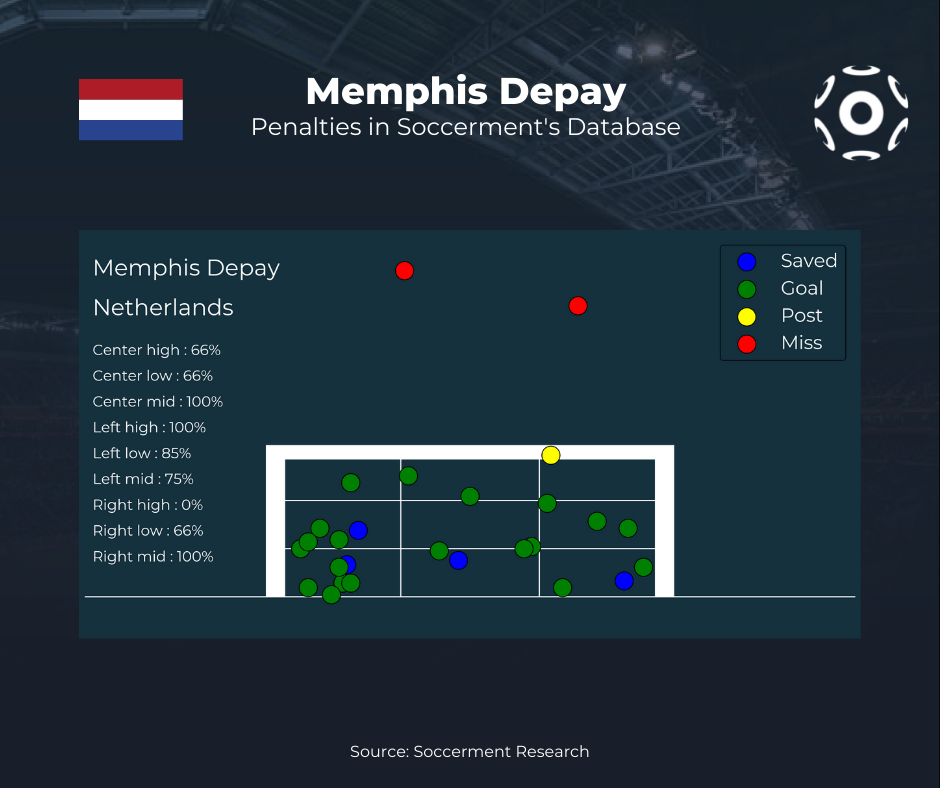
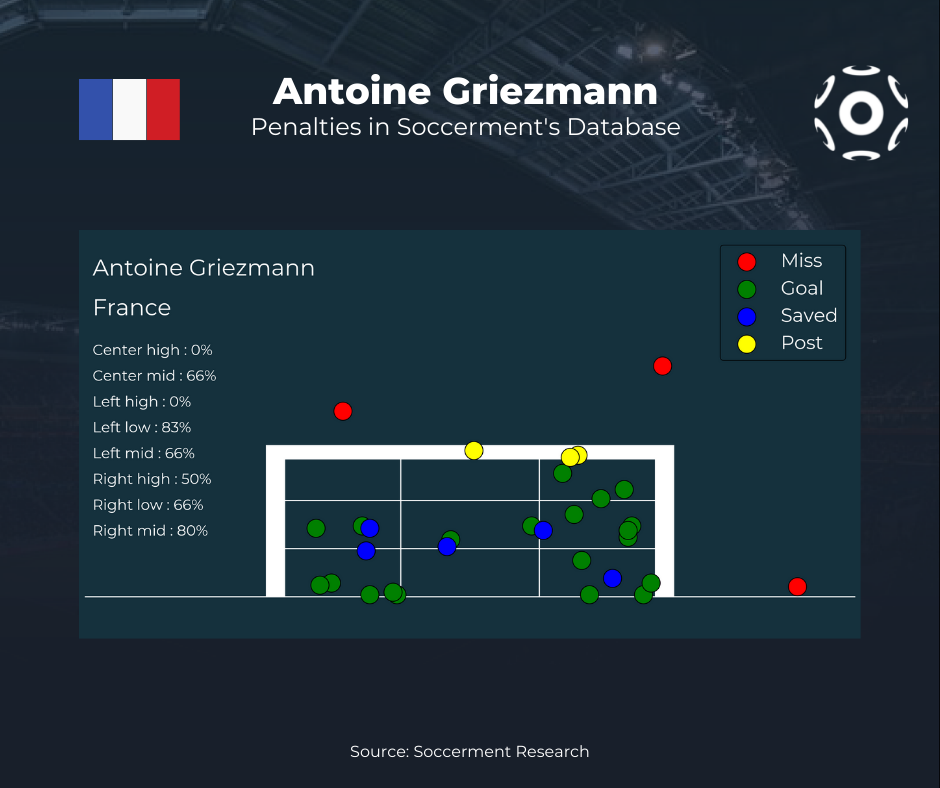
Italy & Spain
The Italians have had mixed feelings regarding penalties, going from Roberto Baggio’s miss in the 1994 World Cup final to the winning penalty of Fabio Grosso in the 2006 World Cup final. The Italian national team now features lots of players who are their club’s penalty takers, among these we have:
- Jorginho (CHE): 34/40 penalties scored (85% conversion rate)
- L. Insigne (NAP): 24/29 penalties scored (82.8% conversion rate)
- C. Immobile (LAZ): 46/57 penalties scored (80.7% conversion rate)
- D. Berardi (SAS): 30/38 penalties scored (79% conversion rate)
- A. Belotti (TOR): 29/38 penalties scored (76.3% conversion rate)
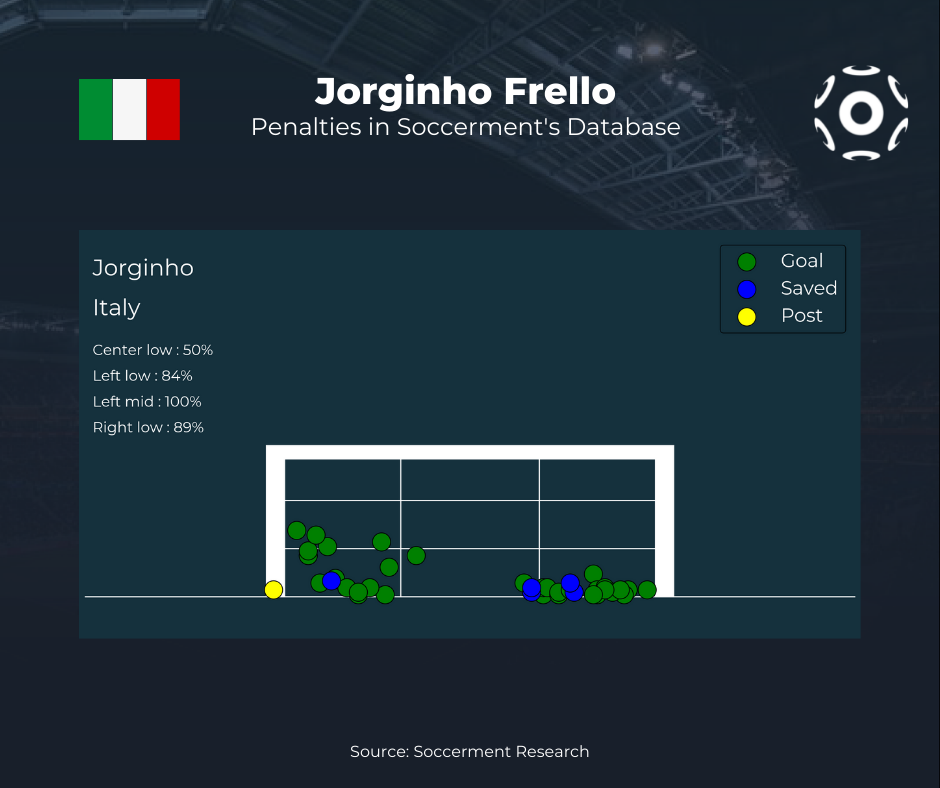
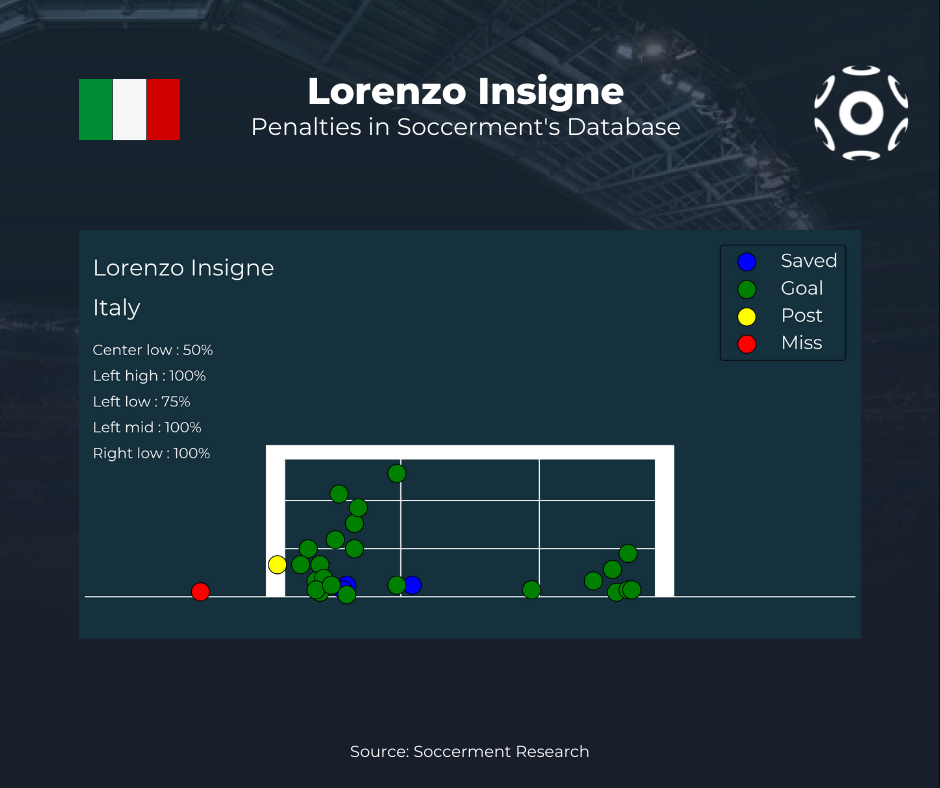
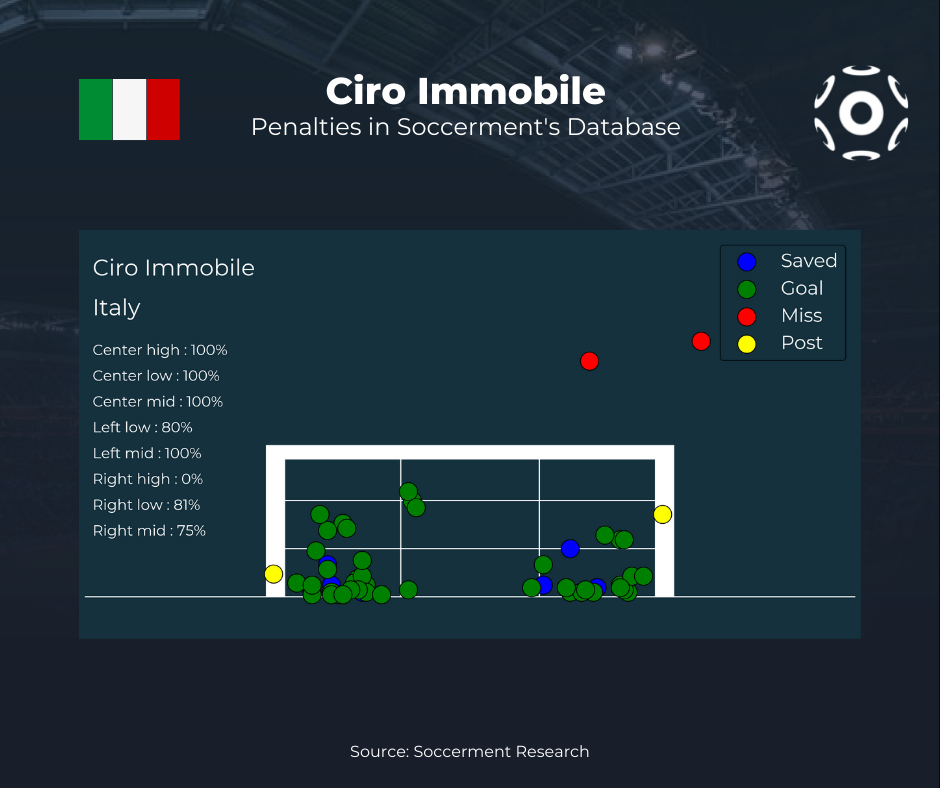
On the other hand, Spain have a poor track record regarding penalties. They are the team which has missed the most at the current EUROs, during matches (7, as of 23rd June 2021). There have been many discussions regarding who should be their penalty taker. Let’s take a look at the best shooters by conversion rate:
- M. Oyarzabal (RSO): 17/20 penalties scored (85% conversion rate)
- A. Morata (JUV): 11/13 penalties scored (84.6% conversion rate)
- G. Moreno (VIL): 16/21 penalties scored (76.2% conversion rate)
So, if on the pitch, we think that Oyarzabal should be the designated shooter, Morata has always maintained a solid conversion rate up until the EUROs, therefore designing him as the shooter for his team was a sensible decision, in our view (his recent miss will bring this figure marginally down, as with G. Moreno).
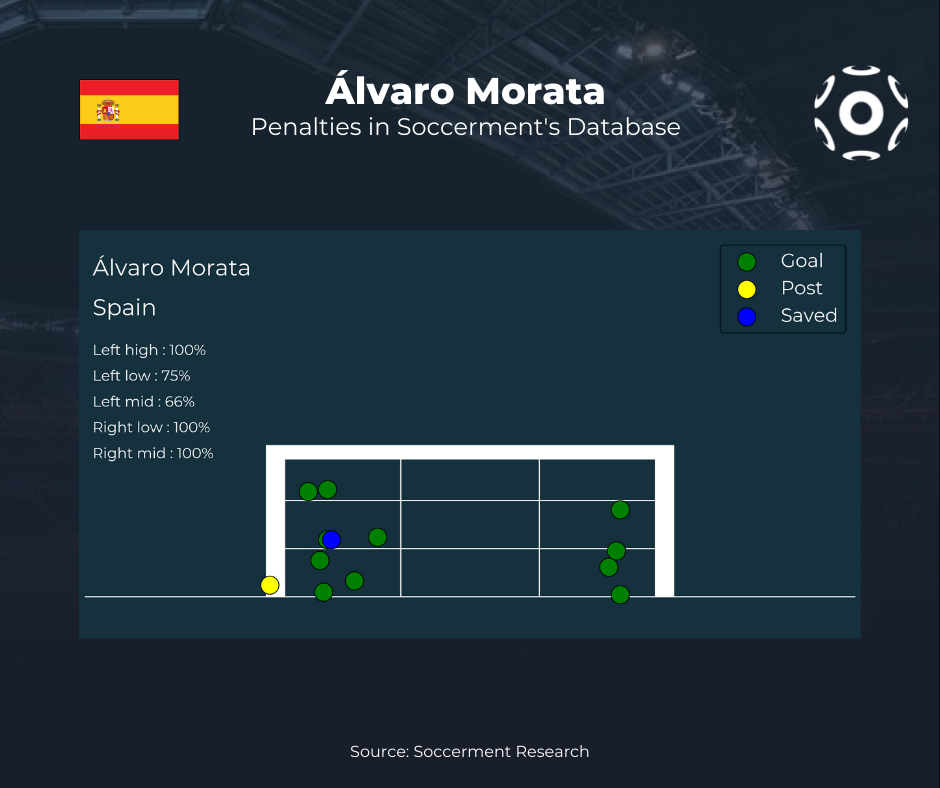
Evaluating the best teams
Having the best penalty shooter can be an an enormous advantage for teams in the knock-out stage. However, when it comes to penalty shoot-outs, it is obviously important to have more than one good penalty shooter, as well as a strong or “specialised” goalkeeper (i.e. Tim Krul at the 2014 World Cup).
Among the teams participating in EURO 2020, if we consider all penalties taken by the players in the squads of the knockout stage, Ukraine display the highest average conversion rate (90.3%), but this comes from just three players (Yarmolenko, Malinovskyi and Zinchenko, two of which are regular penalty-takers). This might suggest that they have good designated shooters, but not much depth.
The next best team is Portugal (with a conversion rate of 83.5%), which not only have two of the three best shooters by conversion rate (Bruno Fernandes and Sergio Oliveira), they also have Cristiano Ronaldo, who is by far the player with the most penalties taken and scored. Plus, André Silva is another good penalty taker.
To complete the podium, we have perhaps surprisingly Switzerland. Their conversion rate of 83.1% is consequence of shooters such as Ricardo Rodriguez, who has taken by far the highest number of penalties in his career, among the Swiss players and then Fabian Schär, Xherdan Shaqiri and Haris Seferovic. However, similarly to Ukraine, only four players have taken at least five penalties (as of our DB, at least), so they could struggle in case of particularly long shoot-outs, otherwise they could have just enough cover to pull off an upset.
Some issues with penalty shoot-outs? The English case and why this year could be different
Ever since England decided to join the international competitions (1950 World Cup, the edition of the famous Maracanazo), they have kind of struggled to impose their dominance. The victory at the 1966 World Cup played on home soil remains the only major tournament won by the Three Lions to date. Since the introduction of the penalty shoot-outs in 1976, England have participated in eight shoot-outs, winning just twice and losing the other six.
Let’s take a deeper look at their track record: England have taken a total of 40 penalties at shoot-outs, scoring 27 times, this means that their conversion rate is of 67.5% which is significantly worse than the average (75-80%). Their best performance came at the 1996 EUROs which were played on home soil, while their worst performance came at the 2006 World Cup, hosted in Germany. At the tournament, England faced two shoot-outs for a total of ten penalties. Despite missing only one penalty in the whole tournament, that proved fatal, as Germany managed to score all of their penalties, shattering once more England’s hopes of lifting a major trophy.
With the exception of the last edition of the World Cup (against Colombia), England have maintained a conversion rate lower than average in all other appearances:
- World Cup 1990: 3/5 penalties scored (60% conversion rate)
- World Cup 1998: 3/5 penalties scored (60% conversion rate)
- EURO 2004: 5/7 penalties scored (71.43% conversion rate)
- World Cup 2006: 1/4 penalties scored (25% conversion rate)
- EURO 2012: 2/4 penalties scored (50% conversion rate)
The poor conversion rate is probably due to a mix of psychological factors, such as pressure and bad luck considering that the penalty-takers on average display higher conversion rates.
The English squad seems well equipped on penalties this year
If England were to face a shoot-out in the knockout stages and their best five shooters by conversion rate with at least four attempted penalties were all on the pitch (Kane, Rashford, Mount, Maguire and Sancho), they would have an average conversion rate of 86.7%. If we weight the average with the amount of penalties taken, the average becomes 87.2%. So, on paper, England seem to have the personnel to continue to invert their poor run of form in penalty shootouts.
- Harry Kane: 44/50 penalties scored (88% conversion rate)
- Marcus Rashford: 12/14 penalties scored (85.7% conversion rate)
- Mason Mount: 4/5 penalties scored (80% conversion rate)
- Harry Maguire: 4/5 penalties scored (80% conversion rate)
- Jadon Sancho: 4/4 penalties scored (100% conversion rate)
- Raheem Sterling: 4/9 penalties scored (44.4% conversion rate)
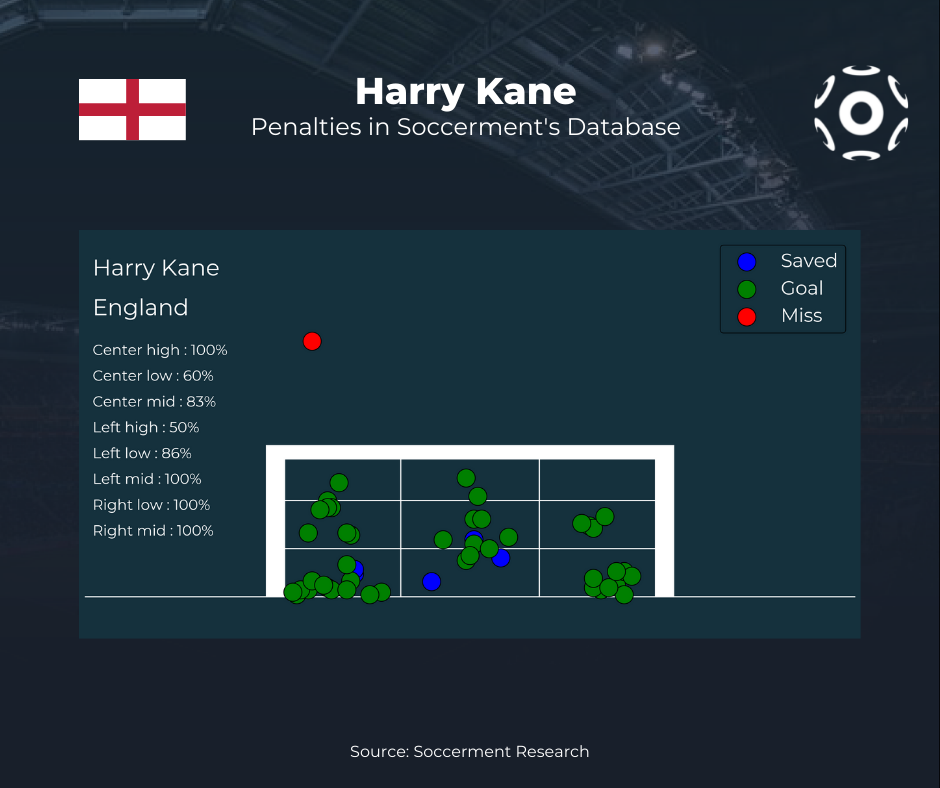
But in case of a shoot-out against Germany in the Round of 16 how do they compare against them?
Historically, Germany is very efficient on penalties
Germany have participated in seven shootouts (four as West Germany) at World Cups and European Championships, winning 6 of them. The Germans’ only defeat (for West Germany to be precise) came at the 1976 European Championship: the shootout was decided by perhaps the most famous penalty ever taken: the chip by Antonín Panenka, which awarded Czechoslovakia the European Championship.
Out of 37 penalties taken at the World Cups and European Championships, Germany have scored 32, meaning they have a very high 86.5% conversion rate at the final stages of tournaments. On four occasions, the Germans have been perfect from the penalty spot, while their worst performance came at EURO 2016, where despite missing 3 of their 9 penalties they still managed to advance to the next stage at the expenses of Italy.
- EURO 1976: 3/4 penalties scored (75% conversion rate)
- World Cup 1982: 5/6 penalties scored (83.3% conversion rate)
- World Cup 1986: 4/4 penalties scored (100% conversion rate)
- World Cup 1990: 4/4 penalties scored (100% conversion rate)
- EURO 1996: 6/6 penalties scored (100% conversion rate)
- World Cup 2006: 4/4 penalties scored (100% conversion rate)
- EURO 2016: 6/9 penalties scored (66.7% conversion rate)
Among their ranks, the Germans have a number of penalty-takers, while only a few have taken a high number of penalties, the average conversion rate tends to be very high, suggesting there is considerable depth among their ranks.
However, among the top five players in the German team for penalties taken, we have Reus (16/21, 76.2% conversion rate, close to average) and Werner (13/18, 72.2% conversion rate, below average), who have lower conversion rates than many of their teammates. Havertz and Halstenberg have a 100% conversion rate having took 8 and 7 penalties respectively.
- Ilkay Gundogan: 15/17 penalties scored (88.2% conversion rate)
- Kai Havertz: 8/8 penalties scored (100% conversion rate)
- Toni Kroos: 5/6 penalties scored (83.3% conversion rate)
- Thomas Muller: 33/41 penalties scored (80.5% conversion rate)
- Marcel Halstenberg: 7/7 penalties scored (100% conversion rate)
- Serge Gnabry: 2/4 penalties scored (50% conversion rate)
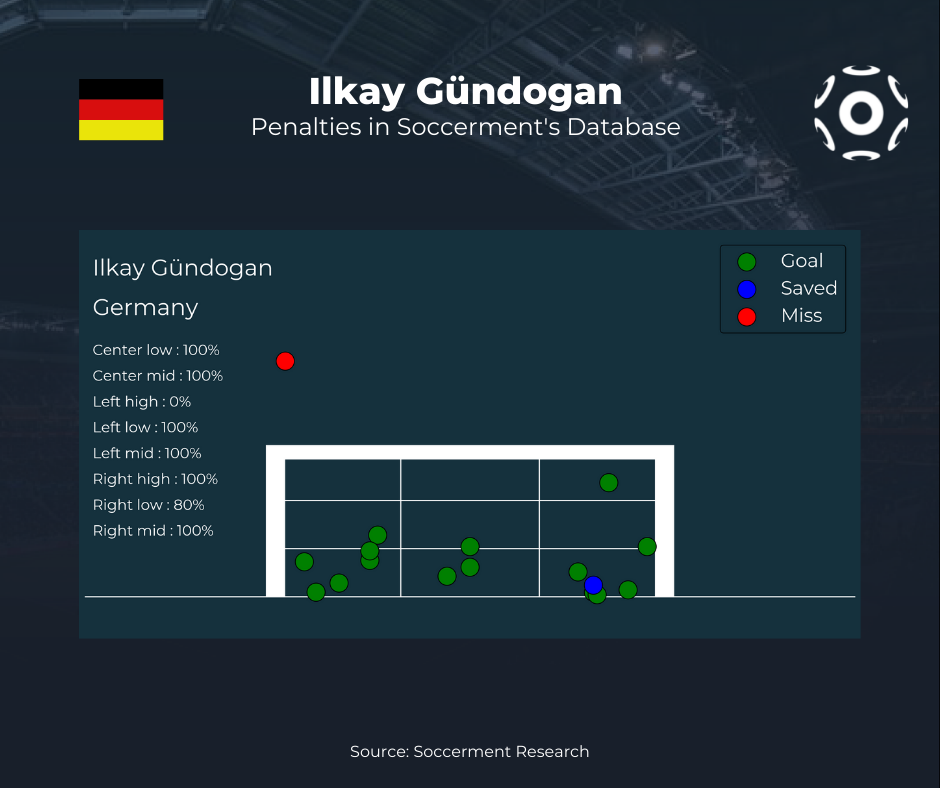
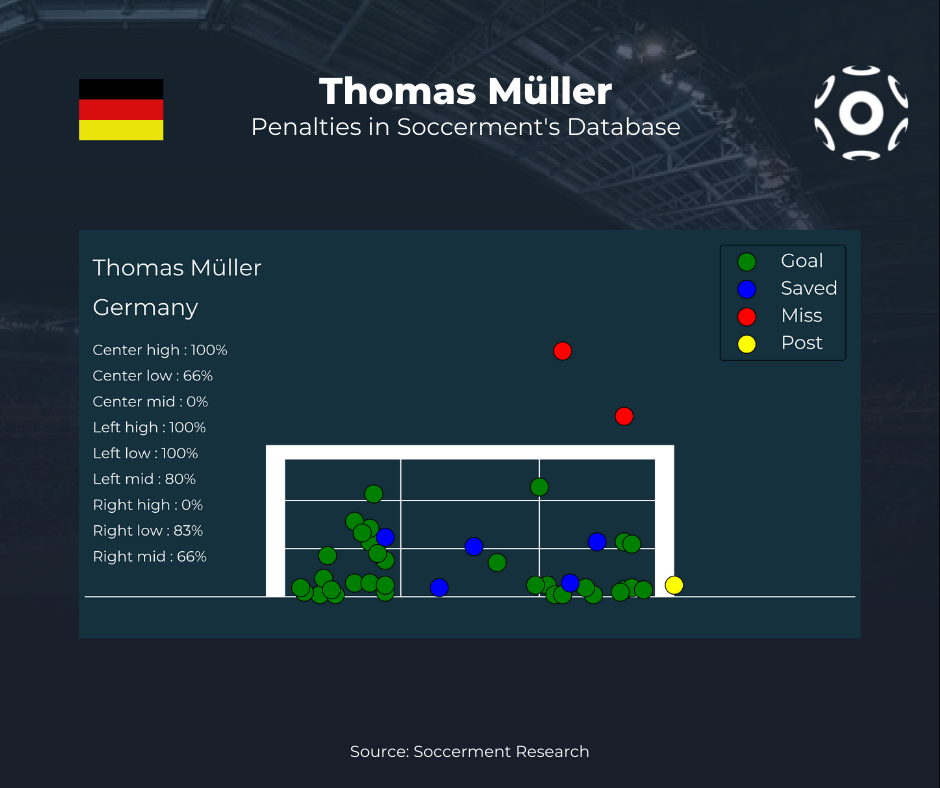
Are you ready for the knock-out stages of UEFA EURO 2020? Are you expecting any Panenka during the penalty shoot-outs? Who has been the best wonderkid so far in the tournament? Read our Wonderkids: 2021 Outlook!
[ec_product productid=”12″ style=””]Interested in football stats? Sign up for free to Soccerment Analytics and start analysing football players and teams through intuitive data visualisation and innovative performance indicators.
For any query, suggestion or comment, feel free to send us an email: research@soccerment.com.
If your dream job is in the sport analytics arena, send us your curriculum vitae: cv@soccerment.com.

